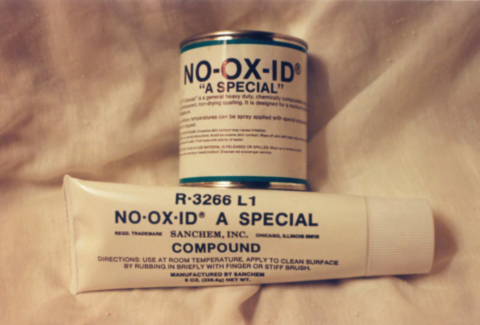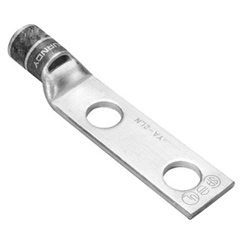Try our solar cost and savings calculator
Copper Buss Bars
Collapse
X
-
This sounds just the ticket for the stupid Volvo fuses I have to remove and clean yearly. >
Leave a comment:
-
[
Last tip on No-Ox is don't trap yourself inside a box it is for electrical only. On anything you do not want to corrode, or where two dissimilar metals are used like copper and aluminum.
So much for that 2 oz. lifetime supply.
All good info though. Thanks for sharing your experience.
Leave a comment:
-
OK here i show you use it, so pay attention to details.
1. On your battery Term Post is Scotch Brite or brass brush to clean all exposed surfaces to a shiny finish. Do not over due it. Clean it with Acetone or Alcohol.
2. Apply a very light coat of No Ox to all exposed surface including inside the Bolt Hole.
3. On all mating surfaces, buff contact surface lightly with Scotch Brite to get a shiny finish. Be careful on plated copper compression terminals. If you see copper you went to far. Clean as above.
4. Apply light coat to mating surfaces, compression barrel, all hardware, and make everything sticky from top to bottom. Don't get it messy, just a light coat.
A bit late for this, but for connectors close to batteries also get No Ox applied on wire sinners and inside compression barrel to seal out oxygen and acid from wicking action of any exposed wires.
Last tip is buff up your grounds buss with Scotch Brite to make it shinny. The immediately apply a thin layer. No-Ox. When I say thin, I mean like furniture polish. Wipe on a little No-Ox with a soft cloth very lightly, then polish it off with a clean cloth. Get it all buffed in, and that bar will remain shiny for years locking out oxygen from touching the surface. .
Last tip on No-Ox is don't trap yourself inside a box it is for electrical only. On anything you do not want to corrode, or where two dissimilar metals are used like copper and aluminum.Last edited by Sunking; 10-09-2018, 10:58 PM.Leave a comment:
-
Ordered a 2 oz jar, should last me forever...Leave a comment:
-
They also make it in a what I would call a Snuff Can or Chewing Tobacco Can. Pretty much a life time supply for $3 or $4 bucks. In a location if you cannot get a good anti-oxidant, Vaseline will work and when used on skin keeps acid off skin when working with acid.Last edited by Sunking; 10-09-2018, 09:16 PM.Leave a comment:
-
A tube of No-Ox will last well beyond your grand children life time long after you have turned to dust. I have battery plants that are 40 years old with absolutely no corrosion issues. It is the only product allowed to be used by utilities, CATV, Cellular, Telephone, Water Plants, Generation Plants, and Bridges.

I just pulled my tube of No-Ox out the other day only to find the threaded nozzle had cracked off at the base. Probably the Baja summer heat degrading the plastic like every other plastic item that goes through a couple summers in Gods Furnace of Northeastern Baja.
Note to self.... Next time buy it in the tin can.
Leave a comment:
-
I will add something to secure the cables to as I hadn't given any thought about them getting jarred and loosened.
As far as juice is concerned, not much as I am only supplying a 24V 1500W inverter so I guess around 60 - 65 amps max. I didn't make the bar with intentions of running tons of current through them but to hopefully help the parallel strings charge more evenly.
I have ordered a small jar of the compound referenced by sunking and will clean and reattach the cables as he described. I had always used silicone grease in the past and in the Army we used just wheel bearing grease on battery terminals!
As far as the double-holed terminals I had no idea such a thing existed so I have fulfilled today's requirement toward my lifelong philosophy of "learning at least one new thing per day."
Leave a comment:
-
So if it were me with what you have now I would make 3 corrections.
1. Drill the threads out just enough to allow your bolt to pass through with a snug fit.
2. Remove every thing from the Bus Bar, then take Green Scotch Brite and buff both the Buss Bar and Terminals to a nice shinny finish. Clean off with acetone. Be careful with the terminals not to buff down too far and remove the tin/lead plating. If you see red copper, you went to far.
3. Apply a very light coat of No-Ox-Id "A" Special made by Samchem to mating surfaces, hardware, and wire skinners.
I assume you know what is going to happen with a steal bolt threaded into copper right? If not you failed chemistry class. Well in about 6-months time or later will come a time when you need to remove a bolt and lug for maintenance. Good luck taking it apart. Your bolt will likely break apart as you apply torque because it has fused with the copper via electrolysis because you used dissimilar metal which made an Anode and Cathode. If you had used Straight Though Bolts with Antioxidant, you would have eliminated that failure point.
A tube of No-Ox will last well beyond your grand children life time long after you have turned to dust. I have battery plants that are 40 years old with absolutely no corrosion issues. It is the only product allowed to be used by utilities, CATV, Cellular, Telephone, Water Plants, Generation Plants, and Bridges.
No Ox is so good, they employed Cyclone Fence Company in NOLA to run a 50 year test. Back in the 70's they had Cyclone Fence put of a Chain Link Fence up at the factory. Heated up the No-Ox so it would liquidfy, diluted with acetone, and sprayed the fence. That fence has been submerged 3 times in sea water and blasted with God only knows how many hurricanes and to this day, no corrosion. Ever seen a 10 year old chain link near a coast?? Nope you have not unless it was protected somehow.
 Last edited by Sunking; 10-09-2018, 12:53 PM.
Last edited by Sunking; 10-09-2018, 12:53 PM.Leave a comment:
-
Confused how? Here is a #6 AWG two-hole compression terminal There is no possible way a single hole lug can match two-hole. There is over 300% more surface area and twice the pressure applied to surfaces that cannot be torqued off.
 Last edited by Sunking; 10-09-2018, 12:20 PM.
Last edited by Sunking; 10-09-2018, 12:20 PM.Leave a comment:
-
He is referring to lugs that actually have 2 holes. They're common in big power applications in the electrical industry.
like these
I would find a way to secure the cables so they can't vibrate/swivel around and work loose.
How much amperage are you running through the lugs/bars?
Leave a comment:
-
Are you saying I should have cables with a lug that has two holes in it? I'm somewhat confused as no matter how many holes are in the bus bar the lug only has one...
The "bolts" are being used as studs and are 8mm stainless. The cables are torqued down tight with wave lock washers on top of flat washers. The threading in the bars doesn't do anything other than hold the bolts in place so I didn't loose them.
Connections 1.jpg
I have made Lexan "shields" to attach over the top of each bar but don't have them installed yet. Next trip I will wire-brush the bars and apply silicone grease where the lug mates with the bar.
Leave a comment:
-
Maybe or maybe not.Not sure why everyone is making a big fuss about threading the bus bar. OP referred to the bolts as "studs" which eludes to the fact that he will be containing the lugs under a nut. That will allow him to get the torque he needs, as the threads are essentially just holding the stud in place.
Copper tends to flex and those threads are small and can easily move with can loosen up the connection when they experience hot and cold cycles.
It is better to use a stronger metal (then copper) bolt that has threads that allow you to torque the nut tight.Leave a comment:
-
Not sure why everyone is making a big fuss about threading the bus bar. OP referred to the bolts as "studs" which eludes to the fact that he will be containing the lugs under a nut. That will allow him to get the torque he needs, as the threads are essentially just holding the stud in place.Leave a comment:
-
Threads in copper cannot hold enough torque to be useful. You need thru-bolts as stated before, and should use anti-ox on the fittings, otherwise, the copper bar will oxidize and become useless.Leave a comment:
Copyright © 2014 SolarReviews All rights reserved.
Powered by vBulletin® Version 6.1.0
Copyright © 2025 MH Sub I, LLC dba vBulletin. All rights reserved.
Copyright © 2025 MH Sub I, LLC dba vBulletin. All rights reserved.
All times are GMT-5. This page was generated at 09:18 AM.


Leave a comment: